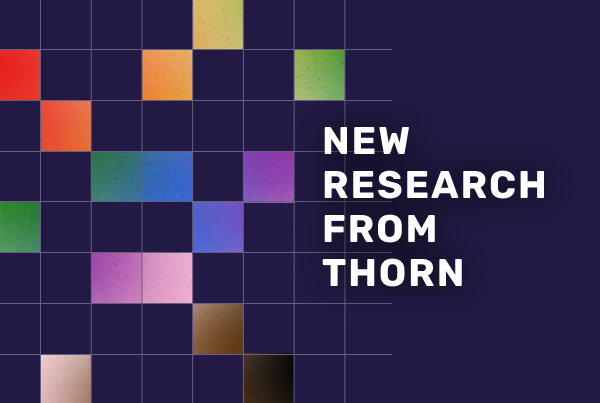At Thorn, we regularly conduct original and comprehensive research that enables us and our partners across the ecosystem to better understand the real-world experiences of young people today.
In our latest research, Perspectives from LGBTQ+ Youth: How LGBTQ+ Youth Navigate Exploration and the Risks of Online Sexual Exploitation, we discovered that Young LGBTQ+ people place enormous importance on online communities as places of exploration and perceived safety – but these platforms also come with their own risk of harm and risky encounters.
The LGBTQ+ minors we surveyed not only rated the likelihood of harm online as higher than their non-LGBTQ+ peers, they reported that they were between two and three times more likely to have experienced unwanted or risky interactions online, such as receiving unsolicited nudes, blackmailing them, or having had an adult attempt to befriend or manipulate them.
What did we find?
Key research findings include:
- LGBTQ+ minors seek online spaces for community. LGBTQ+ youth spend more time in digital spaces and tend to have more online-only relationships than their non-LGBTQ+ peers.
- More than three in four LGBTQ+ minors consider their online communities essential to them, suggesting that digital platforms act as tools for heightened exploration for LGBTQ+ youth and at an earlier age.
- Nearly 1 in 3 participants said they have a secondary account on the same platform – sometimes called “finsta” – and often to create more independence from their offline communities. Among minors, LGBTQ+ respondents were twice as likely as non-LGBTQ+ respondents to have a secondary account (36% vs. 18%) and were more likely to use these accounts to interact with people they only knew online.
- Across all respondents, the top reason cited for maintaining a secondary account was to keep parent activity private.
- LGBTQ+ minors were twice as likely to report sharing their own SG-CSAM (nude) photos or videos. Additionally, LGBTQ+ minors were more likely to report that their friends received unsolicited nudes, shared their own nudes, and leaked without permission.
- Across all age groups involved in the study, LGBTQ+ participants reported higher rates of experiences with sexually explicit images among their friend groups than non-LGBTQ participants.
- Line grooming is considered mainstream. Across all respondents, with little difference between teenagers and young adults, the overwhelming majority (83%) consider the likelihood of adults attempting to befriend and manipulate a minor online as at least somewhat common.
- Views of this risk are even higher among LGBTQ+ teens, with 91% considering this experience to be at least somewhat common.
- LGBTQ+ teens are 10 points more likely to try to handle feelings of insecurity online on their own. Non-heterosexual cis teens are particularly vulnerable, with nearly half saying they would try to deal with feelings of insecurity on their own.
- Among LGBTQ+ teens who choose not to report risky online experiences to their caregivers, 1 in 6 cited outness issues as a factor. For 1 in 5 LGBTQ+ teens, the fear of being cut off from their online community plays a role.
what he tells us
This research confirms what we already knew to be true: that LGBTQ+ minors face unique and heightened risks online – including exposure to self-generated child sexual abuse material – and are likely to be more isolated when they feel unsafe.
Studying how LGBTQ+ youth deal with online risk can help create better interventions and protections against harmful experiences, especially when it comes to sexual abuse, such as non-consensual sharing of explicit images or grooming online. What we have learned is that conversations surrounding the intersection of technology and sexual experiences or other online risks are much less often discussed within families compared to other crucial topics such as puberty, mental health and bullying.
Empower parents and young people:
To close the gap in these critical conversations, we need to equip parents with the resources and support they need to talk openly and often with their children about online harm – both so they can protect themselves and support the friends who can turn to them first and encourage them to get help from a trusted adult. Thorn for parents is an excellent starting point.
At the same time, young people and their peers take an active role in recognizing and navigating potentially risky online interactions when they themselves or their friends experience them. To help you, our NoFilter The youth program exists to provide resources and encourage healthy and informed conversations directly between young people. This highlights the importance of having them more often to help guide children through these complex topics with understanding, empathy and support.
Young people who want to test their knowledge of online safety can visit nofiltr.org/quizzes. And young people can share and receive advice about their behavior online at nofiltr.org/advice.
And after?
Thorn will continue to monitor trends in youth attitudes and experiences in the years to come. We hope this data can be used to inform and implement successful interventions that protect, support and empower all young people as they navigate their digital experiences. To stay up to date with the latest research from Thorn, sign up for our newsletter.
Look at our Instagram live interview with our Head of Research, Melissa Stroebel.



